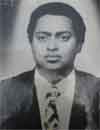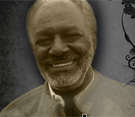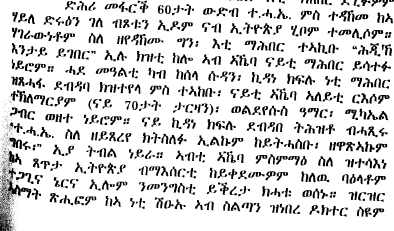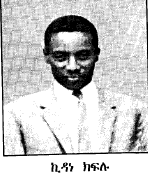The Demise of EFLNA (ENASA) 40 years ago.



"Most Eritrean mass organizations, either at home or abroad, were actively created by either the ELF or the EPLF, EFLNA's relatively uniqueness was that it formed independently of any existing pro-independence movement in Eritrea and sought to retain a measure of autonomy throughout its life"(Gaim Kibreab)
Researched and compiled by Resoum Kidane 22-5-2019
This compilation provides an overview on the rise and demise of EFLNA or ENASA for the acronym of its Tigrinya name (Ertrawiyen nNatsinet Semien Amerika) which was formed by Eritrean students who pursued a higher education degree in the United States between 1965 and 1970. According Mehari (2007) the ENASA emerged out of the spontaneous anger of Eritreans in the US at the civilian killings by the Ethiopian army in 1970. It was not an outcome of an organized or planned effort any group or individuals.ise of EFLNA (ENASA).
Those Eritrean students who arrived to the USA between 1965 and 1970 are believed to have actively participated in the students demonstration that protesting against the political repression and illegal occupation of Eritrea by the Ethiopia government. Their resistant against the illegal occupation was to continue while studying at the University of Addis Ababa in the 1960s. During that period there was a clandestine group at the University of Addis Ababa formed by Eritrean students probably by Kidane Kiflu in the early 1960s.
This group greatly contributed in the revival of Eritrean nationalism among Eritrean students who studied at the University of Addis Ababa in 1960s. Since its formation there was a growing number of Eritrean university students from Ethiopia who joined the ELF or got involved actively in the General Union of Eritrean Students (GUES in abroad).
Despite growing nationalistic sentiments among Eritrean students, large numbers of ELF fighters mostly students gave themselves up to the Ethiopia government because of the ELF leaders’ used religious prejudge and regionalism in the 1960s Haile Durue in his interview with Dan Connell in 2001 also expressed his feeling how the group felt disappointed by the ELF and to leave the ELF.
Regarding this on 29/8/1967, the Tigrinya and Arabic newspapers, ‘Hiberet and ‘Al Wihda’ published that 19 ELF fighters have surrendered to Ethiopia. Among them were Musie Tefamichael and Haile Durue who were the students at Haile Selassie I University.

Picture of the 19 fighters that surrendered to Ethiopia on 28/08/1967, among whom wereMusie Tefamichael (11) and Haile Durue (14)courtesy Mohamed Kheir Omer
Names of 19 ELF fighters who defected to Ethiopia in 1967.
1 Abraha Habteley, 24 years joined the ELF 4 years ago, was 9th grade in Keren
2 Negussie Hizbay 22 years, spent 2 ½ years, student at Teachers Training Institute (TTI), Asmara
3 Woldai Tefai Yohannes, 22 years, spent 14 months
4 Yemane Tesfay, 20 years, spent 1 year, merchant
5 Andeberhan Andemariam, 23 years, spent 2 years
6 Yohannes Liban, 24 years, 2 ½ years
7 Zere Senai Tekle, 22 years, spent 13 months, 12th grade student at General Wingate
8 Haile Woldemichael, 25 years, spent 1 year, was 11th year student at Prince Mekonen Secondary School in Asmara (PMSC)
9 Tesfay Asfaha, 25 years, spent 5 months, 9th grade PMSC
10 Debessay Asfaha, 26 years, spent 3 months, student PMSC
11 Musie Tesfamichael, 20 years spent 7 months and was 2nd year at Haile Sellasie University in Addis Ababa (HSIU)
12 Habtu Tecle, 19 years, student at 12th grade at PMSC
13 Solomon Gebrehiwet, two years, was a farmer
14 Haile Wolde Tensae, 21 years, spent 7 months, was Student at HSIU
15 Yihdego Berhe, 19 years, spent 2 months, student at Hibret School in Asmara
16 Yohannes Mebrahtu, 21 years, 18 months, was 1st year student at HSIU
17 Teklemariam Gebreyesus, 18 years, spent about a year, was student at TTI
18 Wolde Araya, 19 years, spent 19 months, was student at TTI
19 Zeray Tikabo, student at PMSC
source https://hedgait.blogspot.com
In the late 1960s the hundreds students who joined to ELF from Addis Ababa were looked on with suspicion by the ELF leaders. The students at the time referred to as "Sriyet Addis" were executed on mere suspicion of being Ethiopian agents. According various sources these fighters were made to endure unbearable torture at the hands of ELF interrogators; a large number of them were also summarily executed (Paice 1994: 34; Human Rights Wartch 1991: 47; Mengesteab 2005: 43). I
Consequently Kidane Kiflu sent a letter to the Eritrean students studying at the university in Addis Ababa to explain to them the ELF fighters’ situation and advised them against joining the ELF. .
|

Source kab riqe -hefeneti Tekie Beyne (2009: p.123) |
Sadly, Kidane Kiflue who prepared a document describing the illegal annexation of Eritrea by Ethiopia and to distribute during African Foreign ministers meeting at Africa Hall (ECA) was also brutally murdered by the ELF in the late 1969. After the death of Kidane Kiflu, similar letter was sent by Tuku to report on the the unstable political situation in the ELF to the Eritrean students and other former members of Haraka in the Diaspora. Tuku’s letter might have contributed to the split among the Eritrean students in the diaspora at the meeting of General Union of Eritrean Students (GUES) in Munich in the summer of 1970. One group included Dr Fitsum Ghebreselassie, Aregai Habtu, Habte Tesfamariam etc condemned the Kiada al Ama action and the other group supporter of the Kiada al Ama[Omar Jabir, 2005, ].
In the early 1970s when the EPLF split from the ELF, many Eritrean students from the University of Addis Ababa and abroad joined the EPLF as they thought that the EPLF was a progressive organization, However, the ELF’s ’legacy of killing of innocent fighters, didn’t stop in the EPLF, in fact it got much worse. During the 1970s many educated fighters became victims of the EPLF leadership. It is well documented at ehrea.org Teklay Aden who was head of the EPLF security department in his interview also states that the EPLF security department killed no less than 3,000 persons from 1973 to 1980 This is also confirmed by Zekere Lebonna ( 2004) who states that most of the Eritrean elite became victims of their fellow guerrilla leaders, and not of the Ethiopian regimes'. This is not an overstatement.
When many secondary schools and higher education students joined the EPLF particularly those new arrivals from Addis Ababa, they were not welcome by the leadership. Regarding this Mengsteab (2005:51) states that Isaias was never comfortable especially with Musie and Yohannes, and he succeeded to eliminate them. This was the beginning of the front’s harsh response to the dissident movement Menk’a
Apart from those fighters who were physically purged other fighters were also killed in suspicious circumstance. There are still questions to be answered about those cases; some of those fighters were very well-known in the earlier 1970s and mid -1980s. Abraham Tewolde, 1970, Tuku Yihdego, 1971 Weldenkel Haile (Wedi-Haile) 1978,, Isayas Tewelde ( Wedi-Flansa) 1986, Fisehye Woldegebrel, and Ibrahim Afa, 1985, Dr Mekonen Haile, 1981 .
In the late 1970s member of EFLNA( ENASA) Megesteab Yisak and Petros Yohannese were also became victims of the EPLF leadership. In the history of liberation struggle the dedication of EFLNA members who became backbone of EPLF subsequent to the the EPLFforeign missionhead Osman Sabbe split from the EPLF in 1976
During that year with the Front in serious financial difficulties, the member of EFLNA to raise funds for the EPLF, took the decision to quit their study in order to work long hours and live frugally.
Many had scarified the scholarship their received from an illustrious university in the US in order to serve the Eritrean. One of them was Abraham Ghebreghiorgis (MIT) who declined his full scholarship for a PhD in Mathematics at John Hopkins University to serve as one of the EFLNA leadership.
On average ENASA (EFLNA) raised more than two hundred thousand dollar per year and sent it directly to the EPLF, with an active membership of perhaps five hundred people at its height, this average about four thousand dollars per person per year raised exclusive for EPLF. Apart from raising fund, members of ENASA were also actively involved in publishing literature to raise political consciousness of the EPLF mass organisations and fighters. It was also to raise awareness of the Eritrean struggle among non Eritreans in North America which considerable contributed for the formation of Eritrea Support Group campaigns in the USA and Europe in the late 1970s and 1980s.
Initially ENASA was formed to support the Eritrea armed struggle led ELF but later when the EPLF split from the ELF there was an intensive discussions on the internal splits within the ENASA members for the first three years (1970-1973). The repeated failures to connect successfully with the ELF reportedly frustrated ENASA members and pushed them closer to the EPLF
Additionally members of ELFNA (ENASA) thought that the EPLF was a progressive organisation as many of their former friends at the University of Addis Ababa like Mussie and Yohannes had been left wing students who joined the EPLF in 1973. However later ENASA activists heard about the imprisonment of their former friends and classmates who were Menk’a members.
According Kibreab) many ELFNA (ENSA) activists raised questions about the EPLF putatively democratic nature. The Menk’a members who were later executed by the EPLF had many friends and former classmates within ELFNA (ENASA ) and the incident disillusioned more than a few, among them were Mengeastab Ysiak chairperson of ELFNA (ENASA ) and Petros Yohanese co editor of a magazine called Teihsha at Addis Ababa University in the early 1970 and became active member of ELFNA (ENASA ) in Canada.
Meharena Hadgu in Menk’a memory wrote that when Petros was member of ENASA in the USA, he had started inquiring about the injustice of the Menk’a group's arrest. Why were fighters who belonged to it imprisoned? The educated ones asked only for democracy. And what other things have the ELF done? So what was the reason Shabia’s split from ELF them?
Mengeastab who was an influential member of EFLNA’s leadership after raising similar question went to field, in 1975 with Paulos Tesfagiogris to find out what had happened to the Menk’a group.
Regarding this issue Habte Selassie (2007, 338-339) states that in 1975, Mengeastab Ysiak was one of two emissaries EFLNA sent to field to inquire into rumors that EPLF leadership had violated the rights of some prominent members who had challenged Isaias. Mengeateab Ysiak and Paulos Tesfagiorgis were sent to the Field by EFLNA to investigate reports of human rights violations by the EPLF, especially concerning the so called Menka’ movement. Referring to this matter British writer Michela Wrong writes:
“It was Paulos’ first visit to the Front and he found it psychologically overwhelming. The purge had created an atmosphere of fear and suspicion he could feel but barely understand. In daytime he was kept under strict escort, but at night Menka sympathisers sidled up to him to mutter don’t believe everything you hear. He was awed by the austerity of life at the Front, humbled by the Fighters sense of purpose.
Above all he was agonizing aware that to return to a cushioned existence in the West, former classmates who possessed no more than the clothes on their backs were staying behind. To question it all would have felt like gross disloyalty.
The writer then quotes Paulos as saying Habte Selassie (2007 :339) those executed were guilty of incitement and creating division. Our report created calmness. We were the first people from the North American community who had been there, so no one could challenge us. Our word was the word. Single handed, we made the Front look fantastic.
It seems plausible to suggest that Mengisteab, Paulos’ companion in the trip to the Front, was suddenly seized with remorse for the suppression of the EPLF’s alleged wrongs doing. Perhaps Paulos can clarify this point and supply the answer; meanwhile, however, it is reasonable to suppose that a feeling of guilt for making the EPLF “Look fantastic” might have induced Mengesteab’s desperate final actions, including his suicide barely a year after the fateful decision to break from and condemn the EPLF. Habte Selassie (2007, 338-339)
A contributed factors for Megesteab’s suicide could be the EPLF’s control over EFLNA in 1979. Kibreab in his book explans how the EFLNA ceased to exist as an independence organization. According to the author, felling pressure from the EPLF, EFLNA voted at its eight congresses in 1977 to transform itself into two mass organizations: the Association of Eritrean Students in North America (AESNA) and the Association of Eritrean Women in North America (AEWNA). The move places the organization under the control of the EPLF and on an equal footing with all other mass association around the world. However not all members of EFLNA supported the status. Since its inception in 1970, EFLNA had exercised and valued its autonomy and distance, even as it had aligned itself with the EPLF. But pressures to centralize and homogenize all wings of the nationalist movement eventually led to EFLNA’s dissolved in 1979.
It is beyond the scope of this compilation to look in depth the ENASA (EFLNA) division which was happened in 1978. The overall purpose of this compilation is to bring together relevant information written about ENASA by its former member and their sympathiser to help young generation have a background information on the rise and demise of ENASA . It is neglected in the history of the Eritrean struggle for independence.
By 1979, with increasing internal squabbles and in fights within the EFLNA, it ceased to exist as a viable organization and in that year Megesteab Isak died under mysterious circumstances which was a great tragedy for the revolution.
This compilation is also dedicated to remembering former member of ENASA Megesteab Yisak, Petros Yohannese, Abraham Ghebreghiorgis (MIT).and others ENASA member who became scapegoats of the EPLF in 1979.
Background information on the revival of Eritrean nationalism among Eritrean students
Early development of EFLNA
Relation between EFLNA and EPLF (1973-1978)
The demise of EFLNA
Brief background information on the mysterious death of Petros Yohannes 1978
Brief background information on the mysterious death of Megestab Yisaq 1979
Brief biography of Abraham Ghebreghiorgis (MIT),
Eritreans For Liberation In North America (EFLNA) By Mehretab Mehari – Jul 26, 2007
EFLNA/ENASA(Mengisteab Yisaq, Petros Yohannes) & EPLF by By Beyan Negash - Jul 24, 2007






